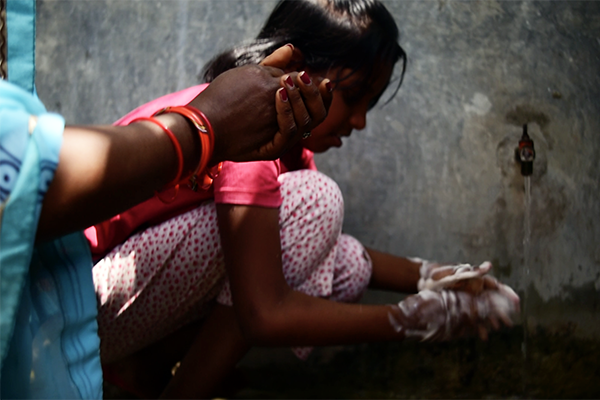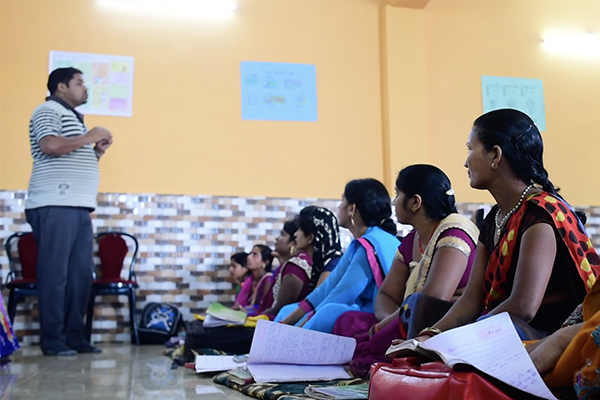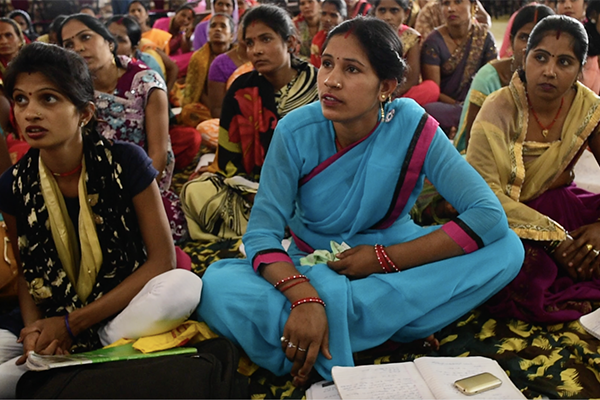Life in lockdown

Above: A girl is taught how to wash her hands by a Community Health Leader, Uttar Pradesh, India. © Matthew Smeal
The COVID-19 lockdown for 1.3 billion people in India posed a very different situation than lockdown in Australia. Jessica Carter, Opportunity International Australia’s Asia Health Program Director—based in Hyderabad, India—explains.
“What I noticed first was the sound,” Jessica Carter said. “India is famous for its cacophony of noises—truck horns, the cries of door-to-door fruit sellers, trumpets from temples or calls to prayer from mosques, and a constant hum of people talking, singing, moving—but with the lockdown, most of that stopped.”
And it stopped suddenly. At midnight on 24 March 2020, India entered a 21-day lockdown, that has since been extended twice. It was announced with only a few hours’ notice.
The suddenness caused a significant disruption to supply chains across the country, affecting access to food and other basic items.
It also left multitudes of people stuck well outside of their hometowns, meaning that many, especially migrant workers, were left with the choice of homelessness or walking hundreds of kilometres in defiance of the lockdown restrictions—and facing traumatic treatment by authorities—back to their villages.
"... with lockdown they simply lost all their customers, and income, overnight.”
For those within their homes, the lockdown created other issues.
“Population density in India is much higher than in Australia,” Jessica said. “So, for many, lockdown means large families (often multi-generational) being stuck in small spaces together. For people in slum communities, this is even harder. These factors affect communicable disease spread, as well as things like increased instances of domestic violence – which we have seen in Australia too.”
“Many people in India work in the ‘informal economy’ running roadside stalls and shops in a very hand-to-mouth existence—they do not have any safety net or JobKeeper allowance—and with lockdown they simply lost all their customers, and income, overnight.”
A country under pressure
The Asia Development Bank estimates that 10.7 per cent of India’s ‘employed’ population lives below USD$1.90 per day. Access to health care was already beyond the means of millions and India’s healthcare system was already under strain.
“India’s healthcare system is poorly funded and fails to reach many people living in poverty – particularly those in rural and remote areas,” Jessica said.
“Government expenditure on health represents slightly more than one per cent of the country’s GDP [compared to almost seven per cent in Australia], which means that health care is limited at the best of times. People living in poverty are further excluded from basic health care and services, even without COVID-19 causing a greater potential burden on the health system.”
Opportunity's health repsonse
That exclusion led to the launch of Opportunity’s health programs in India nearly a decade ago with the knowledge that better health outcomes would also lead to better economic outcomes for the families Opportunity serves.
With a microfinance portfolio that now reaches approximately 5 million poor families in India, Opportunity had a ready-made platform to deliver health education and care to communities that urgently needed it.
“Our program is built around three key obstacles affecting the health of people living in poverty: awareness, access and affordability,” Jessica said.
“Firstly, basic health information such as nutrition or the importance of hand washing, may not be readily available to people who are in poor and rural areas. Also, public and private health services may exist, but people do not know or may not feel entitled to access these. Finally, health services or products may not be affordable to someone living in poverty.”

Above: Women undergo Health Leader training, Uttar Pradesh, India. © Matthew Smeal
To provide health information, Opportunity and its implementing partners train microfinance clients as health leaders to provide community health education. The health leaders focus on different health topics each month and deliver education through microfinance groups and in general community settings.
With coronavirus, the health leaders adjusted their messaging to include COVID-19 and utilised their existing network.
“Primarily the response in India, as well as Indonesia and Bangladesh, has been to share basic messages around COVID-19 prevention and detection. In India, the health leaders are also monitoring community cases and sharing data on that, as well as monitoring community isolation centres where new arrivals to the village must quarantine.
A looming humanitarian crisis
The world is currently dealing with COVID-19 as a global public health crisis. But in a few months’ time, countries like India may be facing a humanitarian crisis as millions of people who were already in poverty struggle to rebound from a shock of this scale.
“The goal of the lockdown is obviously to ‘flatten the curve’ and to try to make the spread of COVID-19 manageable for India’s already under-resourced health system. Sadly, this still may not be enough, which would lead to serious public health challenges for the whole country,” Jessica said.
“In parallel to this, the lockdown could continue to compound impacts on a whole range of areas, including livelihoods and income, supply chains and access to food and essentials, and domestic violence. This compounding could create a humanitarian crisis.”
Now, more than two months since the lockdown began, restrictions are easing. Restaurants, shopping malls and places of worship in much of India are reopening and travel is gradually restarting.
Yet, the number of COVID-19 cases is skyrocketing. India now has the fifth highest number of confirmed cases in the world, at more than 367,000, and experts predict the infection rate will not hit its peak until the end of July. People are already struggling to access care in overcrowded hospitals.

Above: A student health leader listens to feedback following a presentation she just gave to her health leader class. © Matthew Smeal
But there is an additional concern: that COVID-19 could reverse poverty-alleviation efforts by decades and increase the world's extreme poor to more than 1 billion as economies shrink.
“Already, we know that health issues place a large economic burden on many families. If this is the case in ‘normal’ circumstances, these added pressures could have a devastating effect on the country’s poorest.”
According to Jessica Carter, Opportunity is well-placed to provide a much-needed safety net.
“Opportunity’s model relies on relationships – with fantastic partner organisations serving communities in need, the millions of people living in poverty that we serve, and with everyday Australians who are generous enough to give to those people. It is because of these relationships that we can mobilise the long-term support needed,” she said.
“We must provide a safety net that supports people to get through the immediate crisis, and to continue building their lives beyond it.”
Ensuring health leaders are trained is part of Opportunity’s ongoing commitment to people living in poverty – and it is part of our response to COVID-19.